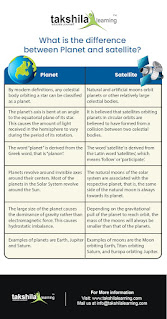Difference between Planet and Satellite
The main difference between a planet and a moon is that the planet is a celestial sphere in which a star or stellar debris orbits directly. A satellite is a man-made object placed in orbit.
| Planet | Satellite |
| By modern definitions, any celestial body orbiting a star can be classified as a planet. | Natural and artificial moons orbit planets or other relatively large celestial bodies. |
| The planet’s axis is bent at an angle to the equatorial plane of its star. This causes the amount of light received in the hemisphere to vary during the period of its rotation. | It is believed that satellites orbiting planets in circular orbits are believed to have formed from a collision between two celestial bodies. |
| The word “planet” is derived from the Greek word, that is “planon”. | The word ‘satellite’ is derived from the Latin word ‘satellites’, which means ‘follow’ or ‘participate’. |
| Planets revolve around invisible axes around their centers. Most of the planets in the Solar System revolve around the Sun. | The natural moons of the solar system are associated with the respective planet, that is, the same side of the natural moon is always towards its planet. |
| The large size of the planet causes the dominance of gravity rather than electromagnetic force. This causes hydrostatic imbalance. | Depending on the gravitational pull of the planet to reach orbit, the mass of the moons will always be smaller than that of the planets. |
| Examples of planets are Earth, Jupiter and Saturn. | Examples of moons are the Moon orbiting Earth, Titan orbiting Saturn, and Europa orbiting Jupiter. |
Read more
Click for Online tuition Class 8 social science

Comments
Post a Comment
Thank you we will contact ASAP.